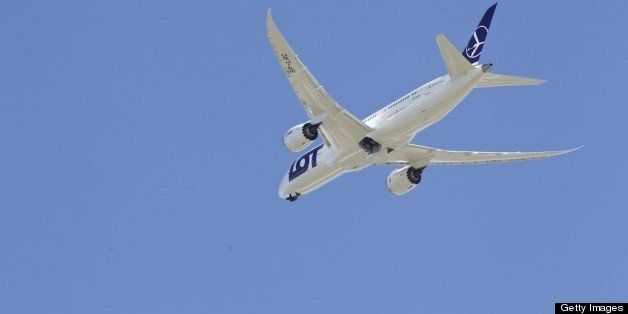
This question originally appeared on Quora. 
Answer by Khaliq Parkar, erstwhile teacher, forever student
Because the plane needs to take off, turn (or bank) and land.
There is more to it than Maximum Take-Off Weight. (the reason for the 46 kg limit)
All aircraft have a certain center of gravity (CG) they need to maintain. The CG is normally one-third from the leading edge of the wing to the trailing edge.
In aircraft design the CG is represented by this symbol:
Spot the CG in this image?
The CG is a point is where all forces exerted on the aircraft are equal (quoted from eHow.com).
Why is this point so important?
a) to take off smoothly in a way that the wings create lift
b) bank without having to strain the body of the aircraft
c) it lands without being bumpy (most of the time) and there is no undue stress on a single part of the plane's body
d) fuel efficiency
Think of it this way, there are hundreds of pieces (on large international flights) having different weights being stuffed all over the aircraft. Plus there is thousands of liters (and kilos) of fuel swirling in the wings and other places which keeps changing in volume and weight as the plane consumes fuel.
Before you proceed, please note:
Freight and Human Beings weigh very different and have different volumes. Humans and their carry on luggage are around 20% of the entire weight the aircraft can carry (there is your checked-in luggage, freight for transport, and, importantly, fuel). Even this 20 odd % broadly gets distributed through averages around the plane. Deviance from the CG is comparatively negligible because of obesity or someone going to the toilet. An onboard computer ensures fuel is distributed across compartments as the flight goes along. What is more important to control is the larger volumes of weight.
Now, before the aircraft takes off, there were these couple of guys who had the tedious job of figuring out a way to keep the CG as close to the ideal point through the journey (computers usually do this job now). If there is a stopover, luggage is going to go on and off the aircraft and the CG will have to be brought back to the ideal again after this stop.
Imagine doing these calculations every time a aircraft has to take off, and it depends on this person/software to ensure there is no undue stress on one screw that is holding the aircraft together (yes it is hyperbole, but I think we should think of the poor guys doing these calculations), or ensure that fuel lasts, and make sure it takes off without a hitch.
Calculations that look like this:
There is some technician sitting there as the luggage keeps coming in ensuring that weight is evenly spread out. He is filling in tedious little boxes to keep a record .
There are load-sheets that look like this:
Now think again about those hundreds of pieces of luggage going on and off the plane and thousands of liters of fuel in the plane.
So how does one swiftly calculate and distribute weight all over the aircraft to ensure it takes off properly and on time, doesn't break apart in mid-air (hyperbole again), and returns safely?
Place an upper limit on size and weight of the luggage.
The reasons airlines are so strict about the top-limit (23\25\27) is because their technicians are working within a set weight and size formula. There are handlers shifting it around and as someone points out, it is unfair to strain them.
Asking you to pay a huge fee for the extra weight (made abundantly clear on the tickets and websites) is just a way to either ensure you don't mess with their calculations, or if you do then think of it as a sort of punitive charge I guess. And yes, to make money if they have space to fill.